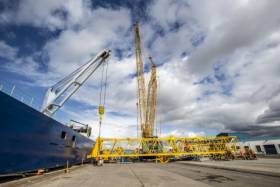Displaying items by tag: Forth PortsGrangemouth
#Ports&Shipping - Afloat has previously reported on Liebherr cranes from it Killarney plant installed at the UK North Sea Port of Hull from where further northward in Scotland at the Port of Grangemouth news of a new multimillion pound container crane has been recently announced.
The new infrastructure is set to increase the number of ship to shore cranes at the Port of Grangemonth by 50% and change the skyline at Scotland’s largest container facility.
The addition of the third Liebherr container crane to Forth Ports’ fleet is part of a major investment programme at the port to increase handling capacity and service for customers. The 45 metre high crane, which weighs 524 tonnes, arrived in large sections on board the heavy load carrier vessel the Eemslift Ellen after sailing from Liebherr’s state of the art facility in Killarney which also designed the crane.
The crane has been unloaded onto the quayside and will now be constructed by the expert build team from Liebherr on site at the port. The crane will be ready to lift its first cargo by late October and will improve vessel turnaround times, increase capacity for growth and support existing operations. The new crane is also future proofed to enable taller straddle carriers to work underneath the crane legs, allowing the port to further increase its overall container storage capability.
Derek Knox, Grangemouth’s Port Manager, said: “This is an exciting time for the port as we welcome our new ship to shore crane. We handle some of Scotland’s most valuable exports, such as fine foods and drinks, so it is important that we deliver fast turnaround times to maintain the vessel schedules and ensure their reliability to service the Scottish export market. The new crane adds to our fleet of Liebherr ship-to-shore cranes and will provide consistency for the operations and engineering team. The Liebherr team will build the crane like a giant Meccano set over the coming weeks and we look forward to its introduction to our operations for the benefit of our customers in the autumn.”
Gerry Bunyan, Sales and Marketing Manager from Liebherr Container Cranes said: “In 2006 the Port of Grangemouth received its first Liebherr ship to shore container crane, a second followed the year after. Since that time, the cranes have been key components in the port’s success. We are thrilled to be able to continue our partnership and supply a third container crane to the port. It is particularly satisfying when a customer recognises the value that a Liebherr container crane can bring to their operation. We look forward to watching this crane help to increase further the business at Scotland’s leading container port.”
Liebherr is one of the world’s leading port crane manufacturers and this new crane, which can handle vessels with 14 containers stowed across the width of the deck, is part of Forth Ports’ focus on maintaining Grangemouth as Scotland’s number one container port. In addition to providing the facilities required to service future container volume growth for export and import cargoes both in European and worldwide markets.
As part of the ongoing major investment programme at Grangemouth, the port introduced three new ESC340 straddle carriers in 2017, increasing the fleet at the container terminal to 16. The port also added a new Hyster empty container handler to the fleet. The new straddles, empty container handler and the new Liebherr crane will increase the handling capacity for both conventional containers and reefers (refrigerated containers). A new terminal operating system and additional storage capacity have also been introduced in 2018. The construction of a new 100,000 sq.ft. warehouse within the port estate is due to be completed by December this year. It will directly link to the container terminal with access to the rail siding.
More than £6 billion worth of goods passes through Grangemouth each year including food and drink, steel plate, timber, paper and equipment for the oil and gas industry.





























































